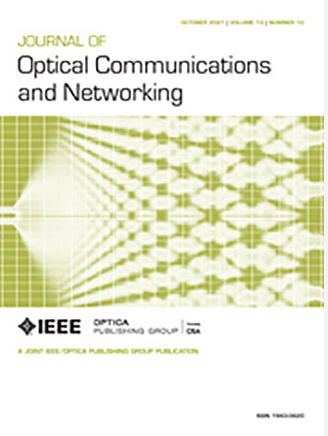通过光树和点对多点相干收发器实现扩展访问聚合
IF 4
2区 计算机科学
Q1 COMPUTER SCIENCE, HARDWARE & ARCHITECTURE
引用次数: 0
摘要
传统上,来自接入节点的流量在使用多个光点对点(P2P)收发器的固定配置中,通过环形或马蹄形在城域聚合集线器中聚合。然而,这种静态设置限制了动态可伸缩性,并且经常导致低效的资源使用和高成本,特别是在不断增加和变化的流量条件下。相干光点对多点(P2MP)收发器为这种网络级别的聚合提供了一种很有前途的解决方案。这些收发器允许单个(聚合)节点通过数字子载波多路复用(DSCM)技术同时与多个(访问)节点通信。此外,它们的远距离传输能力允许将P2MP收发器根放置在层次结构中更深的位置。在本文中,我们提出了一种扩展的访问聚合架构,该架构包含改进的可重构光加丢多路复用器(roadm),以支持传统的P2P和P2P连接。该架构允许创建光树以实现点对点通信,从而提高传输灵活性和多路复用增益。我们提出了一个混合整数线性规划(MILP)模型,以确定P2MP收发器的最佳位置和建立光树,考虑物理层损伤(PLIs)和连接所需的传输质量(QoT)。为了解决高算法复杂度的问题,我们还引入了最佳拟合递减启发式算法,以有效地利用执行时间和性能之间的权衡。我们使用真实网络拓扑的模拟实验表明,我们提出的架构可以在考虑与网络扩展和升级相关的运营成本的同时大大提高多路复用收益。本文章由计算机程序翻译,如有差异,请以英文原文为准。
Enabling extended access aggregation with light-trees and point-to-multipoint coherent transceivers
Traditionally, traffic from the access nodes is aggregated in metro-aggregation hubs over rings or horseshoes in a fixed configuration using multiple optical point-to-point (P2P) transceivers. However, this static setup limits dynamic scalability and often leads to inefficient resource usage and high costs, especially under increasing and varying traffic conditions. Coherent optical point-to-multipoint (P2MP) transceivers offer a promising solution for aggregation at this network level. These transceivers allow a single (aggregation) node to communicate with multiple (access) nodes simultaneously via digital subcarrier multiplexing (DSCM) technology. Additionally, their long-distance transmission capabilities enable the placement of the P2MP transceiver root deeper in the hierarchy. In this paper, we propose an extended access aggregation architecture that incorporates modified reconfigurable optical add–drop multiplexers (ROADMs) to support both traditional P2P and P2MP connections. This architecture allows the creation of light-trees to enable P2MP communication and hence to boost transmission flexibility and multiplexing gains. We propose a mixed-integer linear programming (MILP) model to determine the optimal placement of P2MP transceivers and the establishment of light-trees, considering physical layer impairments (PLIs) and the required quality of transmission (QoT) for the connections. To tackle the high algorithm complexity, we also introduce a best-fit decreasing heuristic to efficiently exploit the trade-off between execution time and performance. Our simulation experiments using real network topologies showcase that our proposed architecture can greatly enhance multiplexing gains while considering the operational costs tied to network expansions and upgrades.
求助全文
通过发布文献求助,成功后即可免费获取论文全文。
去求助
来源期刊
CiteScore
9.40
自引率
16.00%
发文量
104
审稿时长
4 months
期刊介绍:
The scope of the Journal includes advances in the state-of-the-art of optical networking science, technology, and engineering. Both theoretical contributions (including new techniques, concepts, analyses, and economic studies) and practical contributions (including optical networking experiments, prototypes, and new applications) are encouraged. Subareas of interest include the architecture and design of optical networks, optical network survivability and security, software-defined optical networking, elastic optical networks, data and control plane advances, network management related innovation, and optical access networks. Enabling technologies and their applications are suitable topics only if the results are shown to directly impact optical networking beyond simple point-to-point networks.

 求助内容:
求助内容: 应助结果提醒方式:
应助结果提醒方式:


